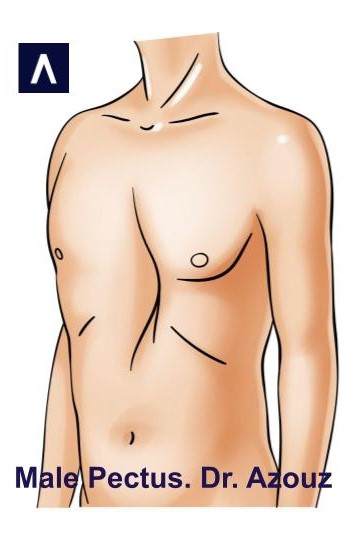Chest Wall Deformity: Pectus Excavatum and Pectus Carinatum Surgery in Dallas
The most common congenital malformations of the bony chest wall are Pectus Excavatum and Pectus Carinatum. Individuals with this condition might have a physiological or psychological impact on their lives. Patients with pectus excavatum and Pectus Carinatum can undergo plastic surgery in Dallas with Dr. Azouz to correct chest wall deformity with excellent results. Request a consultation with Dr. Azouz at (972) 702-8888 and take the first step to correct and improve your chest’s appearance.
Am I a candidate for chest wall deformity surgery?

Chest wall deformities are often genetic and can sometimes be associated with scoliosis, Poland Syndrome, or Marfans Syndrome. The majority of patients will have chest wall abnormalities present at birth or in early infancy. Chest wall deformities are thought to occur as a result of uncoordinated growth between the ribs and chest wall. Trauma can also lead to chest deformity or asymmetry.
These conditions can persist after a thoracic wall reconstruction and many men seek plastic surgery with Dr. Azouz to improve the look of their chest or breasts.
What is Pectus Excavatum?
Pectus excavatum is a concave deformity of the chest wall where the sternum and/or ribs appear to be sunken and is sometimes referred to as a “funnel chest”, or “sunken chest”. Pectus Excavatum usually presents in young infants and babies. Many patients have surgery to correct the bony abnormalities as children.
What is Pectus Carinatum?
Pectus Carinatum is a chest wall deformity that causes the sternum (breast bone) to protrude outward instead of being flat along the chest. Pectus carinatum is also called “pigeon chest” or “keel chest”. Pectus Carinatum usually presents as an overdeveloped sternum and can vary in its severity and can be associated with Poland syndrome.
Plastic surgeon Dr. David Azouz treats common abnormalities of the soft tissue of the chest that present with pectus deformity, including:
- gynecomastia
- lipodystrophy (stubborn fat)
- micromastia (small breasts)
- chest/breast asymmetry
- nipple/areolar asymmetry
- sagging breasts (breast ptosis)
Chest wall deformity surgery benefits
- Excellent long-term functional and cosmetic results
- Restore normal chest expansion
- Reduce chest discomfort
Anesthesia for chest wall deformity surgery
Local anesthesia with sedation is used for patients who undergo surgery to correct the chest wall deformity.
Chest wall deformity surgery recovery
Dallas plastic surgeon Dr. Azouz routinely performs correction of chest wall deformities as an outpatient surgery meaning the patient will go home from surgery the same day. The experience is usually associated with much less discomfort than the original boney surgery the patients have experienced with their prior sternal operations. Patients wear compression garments for six weeks after surgery and Dr. Azouz does not routinely place drains. Patients usually avoid light exercise for 10-14 days after surgery. Patients usually return to heavy exercise including CrossFit, rock climbing, and non-contact sports 6 weeks after surgery.
Scarring after chest wall deformity surgery

Although most patients with pectus deformities undergo repair during childhood, many have persistent scarring and contours abnormalities that can be bothersome later in life. These scars can be hypertropchic and painful. Patients who have undergone heart or lung surgery can also have similar scarring. Although the deformities, asymmetries, or contour irregularities may not be functionally symptomatic, many patients want to correct the look of their chest. Cosmetic pectus surgery for these conditions can be affordable, and the cost is often not prohibitive.
Combination of a chest wall deformity surgery with other plastic surgeries to improve the chest’s appearance
The Nuss and Ravitch procedures are effective surgeries in improving the shape and contour of the chest wall to avoid compression on the heart and lungs. Unfortunately, many patients are left with contour irregularities, scarring, and persistent aesthetic deformities of the chest. Men often will have concurrent gynecomastia or significant asymmetry. Dr. Azouz can utilize multiple techniques to improve the chest’s contour in patients who have had previous chest wall surgery.

- Pec implants
- Liposuction
- Removal of Gynecomastia
- Nipple/Areolar reduction or augmentation
- Fat Grafting
- Scar Revision
Chest wall deformity surgery cost
Correction of chest wall deformity/ Pectus surgery costs can widely vary. Patients should consider facility, surgeon’s fee, anesthesia, location, and post-operation expenses in the final surgery cost. Dr. Azouz will determine the cost of chest wall deformity repair surgery after a physical examination of each patient and provide information regarding financing options to make affordable chest wall deformity surgery for his patients.
Chest wall deformity surgery results
A number of studies have demonstrated high satisfaction after plastic surgery in patients with a history of chest wall deformity. Patients often feel more comfortable in swimwear and with tight-fitting clothing.
Schedule a consultation with Dr. Azouz
Many patients choose to improve their chests with pec implants, liposuction, and scar revision. Schedule our in-person consultation with Dr. Azouz today by calling (972) 702-8888 or contacting us online to request your virtual consultation.
Frequently Asked Questions
Pectus excavatum and pectus carinatum is usually a cosmetic concern for older patients. In childhood and especially at birth the condition can be dangerous and often requires thoracic surgery.
While pectus deformities that are mild may be less noticeable as a patient gains weight and breast tissue, they are anatomic disorders of the rib cage that do not generally go away on its own.
Pectus excavatum or carinatum can look better or worse depending on a patients body weight and chest size. Many patients feel they look more asymmetric if they have enlargements of the breast or if they have gynecomastia tissue.
Exercise can enlarge the pectoral muscles but does not generally fix a pectus deformity.
Pectus deformities such a pectus excavatum typically run in families.
